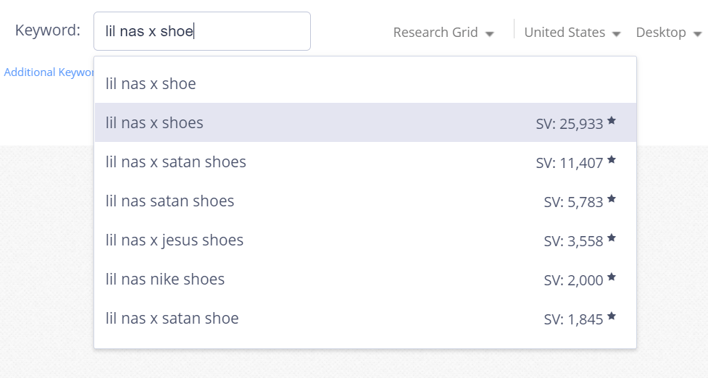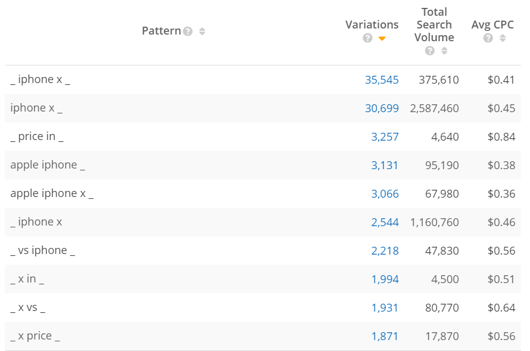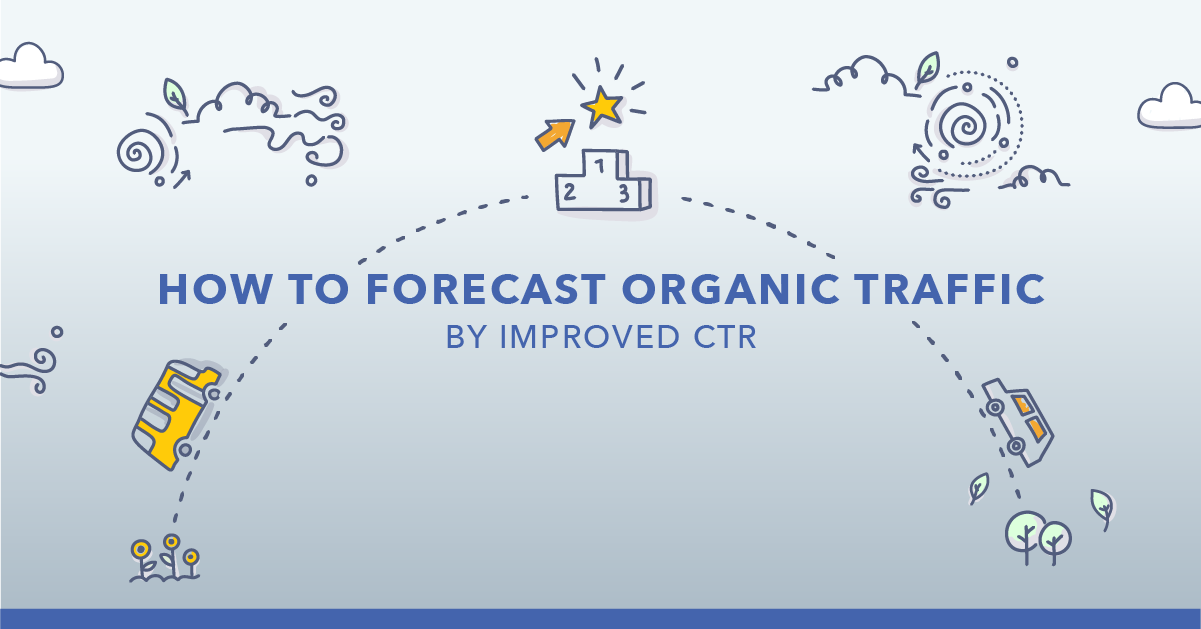One of the most well-known data metrics that marketers and SEOs rely on to make informed decisions is keyword search volume. Despite its popularity, one constant question remains: “What is the true search volume?”
For years, there hasn't been a concrete answer to this question because, really, there hasn't been an “accurate search volume,” even when it comes to Google’s estimates.
Until now...
Following years of frustration with Google Keyword Planner's unreliable search demand data, True Demand now provides SEOs with accurate search volume insights.
Below, I'll address eight significant drawbacks of traditional search volume data and unveil how True Demand sweeps them all aside.
Table of Contents:
What is Search Volume?
Search volume is a broad estimate that search engines (usually Google) provide that indicates how many times the users of that search engine searched for a particular keyword over a certain amount of time.
Google’s numbers come from their Keyword Planner, which is a tool that was built specifically for Google Adwords and PPC efforts – that is, to help advertisers choose the right keywords to target – but SEOs leverage it in order to understand the terms that have a high demand.
This information then allows them to prioritize keywords for their organic search efforts.
In Google, the numbers are updated once a month – usually between the 15th and the 20th for the previous month’s data. But remember, Google Keyword Planner is an estimate.
Note: Search volume numbers that come from Google's Keyword Planner are always rounded (e.g. 500 instead of 517, or 1,000 instead of 1,225).
Types of Search Volume
There are two different kinds of search volume estimates. The first is average search volume, which is the average of the past 12 months’ worth of search volume numbers.
This version of search volume is the default metric reported in the Adwords Keyword Planner.
The second type of search volume is monthly search volume. This method and metric is each keyword’s search volume listed individually by the month.
This approach can be great for identifying trends in seasonality, since different months will have different highs and lows depending on major events, holidays, etc.
Recommended Reading: SEO Metrics: Why to Trust Weighted Average Rank Over Average Rank
Take a look at the chart below, for example. This is the search volume for the keyword “winter jackets” in our Topic Explorer.
The term has little to no demand in the summer, and an increase in demand that starts in September leading into the winter months.

(Search volume for the keyword “winter jackets” in Topic Explorer)
The Drawbacks of Search Volume
Traditional search volume data may seem precise and trustworthy due to its prevalence, but there are many drawbacks that you need to know.
These problems, after all, could have a large effect on your overall SEO strategy.
#1. There is No Correlation Between Search Volume and Traffic
You’ve probably been in this situation yourself: you’re conducting keyword research and tag those with the highest search volume to go after.
After all, if there is more demand for those keywords, that must bring more traffic to your site, right? Well, not always.
High search volume does not guarantee high traffic. Especially with the rise of zero-click searches, where users can find the relevant information they need directly on the SERP.
(The converse can also be true, where a searcher does not see anything relevant and conducts a new search without having clicked anything.)
But just because a keyword has a low search volume does not make it useless – it can very much be worth targeting.
You still want to build your content cluster around a main topic to prove your topic authority on the subject matter as a whole, so don’t dismiss small search volume keywords. (More on this below.)
Plus, you sometimes will have a better understanding of your business than the information Google presents to you.
#2. Search Volume is a Sampling of Billions of Queries
As previously mentioned, search volume is a very broad estimate.
But how broad, exactly?
Search engines use an exceptionally small sampling (3% based on Google's knowledge base) of the billions of queries that take place on their search engine to estimate the search volume.
It is in no way an accurate representation of true search volume.
#3. Adwords Combines Keywords, Even if Those Keywords Have Different Search Intent
Search volume has no understanding of the context behind search queries – it’s a purely quantitative metric.
For example, consider the query “apple.” Does it refer to apple.com, information about the fruit, images of apples?
Of course, the searchers themselves know, and those potential meanings are vastly different search journeys.
So although the search engine tries to understand search intent and present relevant information, the search volume estimate has no understanding of this, and will group all different intents into one number.
Search intent informs the type of content that you should create to target customers along their respective search journeys.
Being limited when it comes to search volume and its relation to search intent creates roadblocks and confusion, and yet again reinforces the fact that traditional search volume estimates aren't accurate.
#4. Information for Brand New Keywords Will Be Skewed
When dealing with average search volume (data of the past 12 months) there is inherently going to be some issues when new keywords arise throughout the year.
If a product was launched in December, for example, the search volume would be much lower than it actually is, simply because there were no searches for that (at the time, non-existent) product for the past 11 months.
Consider the iPhone X. Released in November 2017, there were not too many searches prior to this date (besides perhaps searches made speculating about product release dates and features).
After its release, searches for this product surged, but since there were 10 entire months with little to no searches, the average search volume skewed low.
Tip: In this situation, look at monthly search volume instead to get an understanding of the searches on a month-to-month basis.
#5. Search Volume Cannot Be Sorted By Device Type
It’s not enough to create a list of keywords and track them – knowing which device the search occurs on is arguably just as important as the search itself.
You cannot forget about the push toward mobile as websites continue to become mobile-friendly and the amount of mobile search users continues to rise.
Unfortunately, search volume cannot be categorized by device type, which limits your understanding of how the user conducts the search.
#6. Google Shows the Same Search Volume for Variations of the Same Keyword
Google began to group similar variations of keywords together in Q2 of 2016. Unfortunately, the grouping of similar keywords can lead to ill-informed decision making for your team. Let’s take a look at an example.
The keywords “pricing of iphone x,” “price iphone x,” and “price for the iphone x” may all have different search volumes, but since Google lumps them together and presents the same search volume for all of them, we’ll actually never know – even though that information could help inform your SEO strategy.
#7. GSC Data Does Not Match Google AdWords Data
This may be the most telling sign that Google's search volume metric is innaccurate: Google’s own data contradicts itself! While the data that comes from Google Search Console says one thing, the data from AdWords says something else entirely.
In fact, a research study published in early February 2020 that compared third-party keyword research tools used Google Search Console data as the “source of truth.”
Rand Fishkin called out the discrepancy in Google’s data (and therefore the perceived flaw in this research) on Twitter.
This uses GSC as the "true" numbers? They don't match paid impression counts in Google Ads well enough for me to trust 'em, so that really throws a wrench in this research.
— Rand Fishkin (@randfish) February 6, 2020
#8. Google Hides Search Volume for Certain Keywords
Google has started to hide search volume for certain terms for legal reasons, privacy concerns, or issues with their policies.
If you search for something that Google doesn't allow bidding or advertising on, it won't show any search volume for that term.
This includes things like weapons and drugs, and is sometimes the case with pharmaceutical drugs, actually.
The lack of data creates problems for companies in those industries (casinos and gambling, for example), where certain terms may show as not having any search volume.
You may know that these terms do indeed drive traffic to your site, and that impressions show on Search Console, but search volume data is not there.
This situation only affects about less than .5% of all keywords — but this is a real challenge if you work in one of these industries.
When you see a search volume of 0 when you expect it to be in the thousands, for example, your forecasting models, estimations, and ability to invest are all impacted.
The Solution: The Freshest Search Volume at seoClarity
Given the many challenges of Google's keyword search volume data, we sought to create a solution that would provide our clients with access to fresh, up-to-date search volume.
Clients can access estimated search volume data for those keywords that Keyword Planner tends to hide (including health- and gambling-related keywords) with our True Demand — our estimate of the average monthly searches for a keyword based on clickstream data.
This is completely GDPR compliant with fully anonymous data collected from billions of real user searches.
The clickstream data allows us to create a statistical modeling to calculate these estimated search volume trends. This allows for more specificity in the search volume estimates, as opposed to the broad ranges that Google provides.
 (Search volume estimates for a relatively new topic.)
(Search volume estimates for a relatively new topic.)
You can even compare search volume from Keyword Planner directly next to True Demand.
Look at this example of search demand from Keyword Planner compared to True Demand estimates:

(True Demand in seoClarity's Topic Explorer.)
While Google groups rings, engagement rings, and ring's together (all with the same search demand), True Demand uses clickstream data to get more specific.
Note: All search volume is an estimate. It's meant to be used directionally, so you can prioritize between search terms.
From Keywords to Topics
It's important to be aware that you shouldn’t always be working keyword to keyword, search volume to search volume.
Focus on creating clusters around your main topics. This topic cluster approach proves your complete authority in the subject area.
With Topic Explorer, you can understand a searcher’s journey and find missing content. Then, build out that content to grow your cluster and have a piece of content for every stage of the buyers' journey, no matter what the intent is.

Plus, Topic Explorer makes it easy to do this, with the ability to narrow down our keyword database by industry, and see how people really search with Keyword Patterns.
The example below shows potential search query variations related to the keyword “iPhone X” that can inform your content marketing strategy.

(Keyword Patterns in Topic Explorer.)
Topic Explorer also allows you to filter down the keywords by keyword length. So, for example, you can specify that each keyword be greater than 2 words to find long-tail keywords.
Build out your content centered around long-tail keywords to start becoming an authority with your clusters, and then start to go after high search volume keywords.
Conclusion
Google Keyword Planner's search volume data has numerous drawbacks that call its accuracy into question. But search volume can still serve as a valuable and informative metric for understanding demand and effectively prioritizing SEO campaigns.
To gain access to accurate search volume data through True Demand, schedule a free demo today and get a custom 5-day trial!
<<Editor's Note: This piece was originally published in March 2020 and has since been updated.>>




.png)

Comments
Currently, there are no comments. Be the first to post one!